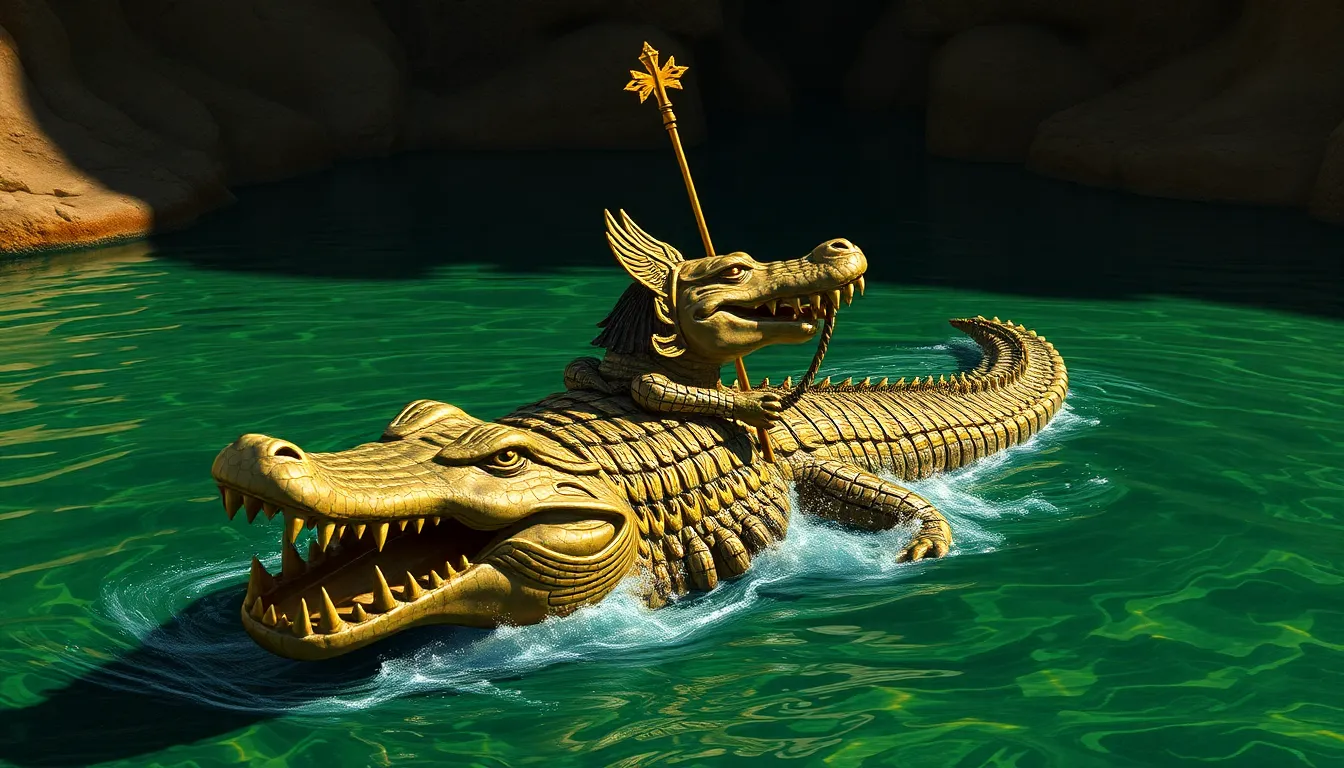The Sacred Crocodile: Worshiping Sobek
I. Introduction
In ancient Egyptian mythology, Sobek stands out as a unique and complex deity, symbolizing both the ferocity of the Nile’s crocodiles and the nurturing aspects of fertility and protection. As a god associated with water, fertility, and military prowess, Sobek played a vital role in the spiritual and daily lives of the ancient Egyptians. The crocodile, revered and feared alike, was not only a predator of the Nile but also a significant symbol of the duality of life and death in Egyptian culture. This article aims to explore the worship of Sobek, the historical context surrounding this deity, the rituals practiced in his honor, and the legacy he leaves in both ancient and modern contexts.
II. Historical Context of Sobek
The origins of Sobek worship can be traced back to the early dynastic period of ancient Egypt, around 3000 BCE. Initially, Sobek was worshipped in the region of Fayoum, where the Nile’s crocodile population thrived. Over time, his significance grew, and he became associated with various aspects of Egyptian life, including agriculture and military strength.
As Egyptian religion evolved, so did Sobek’s role. He was often depicted as a man with the head of a crocodile, symbolizing his dual nature as both nurturer and destroyer. Key archaeological findings, such as the Sobek temples in Kom Ombo and the crocodile necropolis in Fayoum, provide insight into the prominence of this deity. These sites reveal not only the architectural grandeur dedicated to Sobek but also the beliefs and practices of the people who revered him.
III. Symbolism of the Crocodile
Sobek embodies a dual nature, acting as both a protector and a destroyer. This complexity is central to understanding his significance in ancient Egyptian thought. The crocodile symbolizes:
- Fertility: The crocodile was seen as a symbol of fertility, particularly associated with the inundation of the Nile, which brought life to the land.
- Strength: Sobek represented the fierce strength of the Nile, a force that could both nurture and destroy.
- The Pharaoh’s Power: The crocodile was often viewed as a representation of the pharaoh’s power, serving as a guardian of the kingdom and its resources.
IV. Rituals and Practices Associated with Sobek
Temples dedicated to Sobek were architectural marvels, designed to honor the deity and facilitate worship. One of the most notable temples is located in Kom Ombo, which features a unique double temple dedicated to both Sobek and Horus. The rituals and practices associated with Sobek included:
- Common Rituals: Offerings of food, incense, and even live animals were made to Sobek to seek his favor and ensure prosperity.
- Role of Priests: The priests of Sobek played a crucial role in the rituals, conducting ceremonies and maintaining the temple’s sacred spaces.
V. Sobek in Art and Literature
Sobek’s presence is evident in ancient Egyptian art, where he is frequently depicted in various forms. His imagery often includes:
- Sculptures: Statues of Sobek can be found in temples and tombs, showcasing his crocodilian features.
- Paintings: Wall paintings in tombs often depict Sobek in scenes of fertility and protection.
Additionally, Sobek is mentioned in Egyptian texts, including the Pyramid Texts and various hymns, where he is invoked for protection and blessings. In later cultures, Sobek’s image and symbolism have been adapted and reinterpreted, appearing in various forms of literature and media.
VI. The Sacred Crocodiles of Ancient Egypt
Live crocodiles were considered sacred in ancient Egypt, particularly in areas where Sobek was worshipped. The significance of these sacred crocodiles included:
- Worship: Sacred crocodiles were kept in temple lakes and were treated with reverence, believed to be manifestations of Sobek himself.
- Ecological Role: The ecosystems of sacred lakes were maintained to ensure the health and well-being of the crocodiles, reflecting the Egyptians’ understanding of ecological balance.
- Conservation: Care was taken to protect these sacred animals, highlighting the deep respect ancient Egyptians had for the natural world.
VII. Modern Interpretations and Legacy
The influence of Sobek continues to resonate in contemporary spirituality and culture. His legacy is seen in various forms:
- Spirituality: Some modern spiritual practices draw inspiration from ancient Egyptian deities, including Sobek, as symbols of balance and duality.
- Ecological Discussions: Sobek’s connection to the Nile and the natural world prompts discussions about conservation and the importance of protecting ecosystems.
- Art and Literature: Sobek has inspired artists and writers, appearing in books, films, and artworks that explore ancient mythology and its relevance today.
VIII. Conclusion
In summary, Sobek’s importance in ancient Egyptian mythology extends far beyond his crocodilian form. He embodies the complexities of nature, representing both the life-giving and destructive forces of the Nile. The worship of Sobek reveals much about the values and beliefs of ancient Egyptians, particularly their deep connection to the natural world. As we reflect on the enduring legacy of crocodile worship, we recognize the intersection of mythology and nature, and the lessons it offers for modern society in terms of ecological awareness and respect for the environment.




